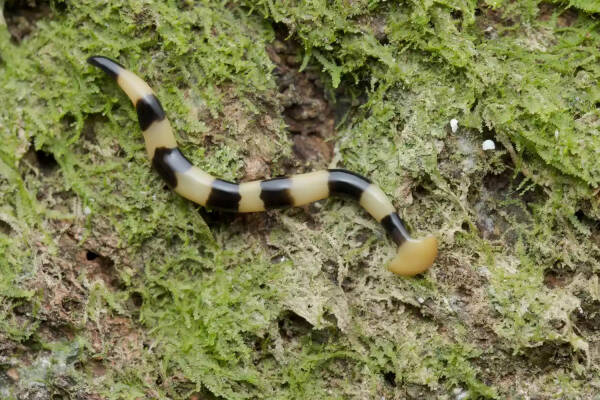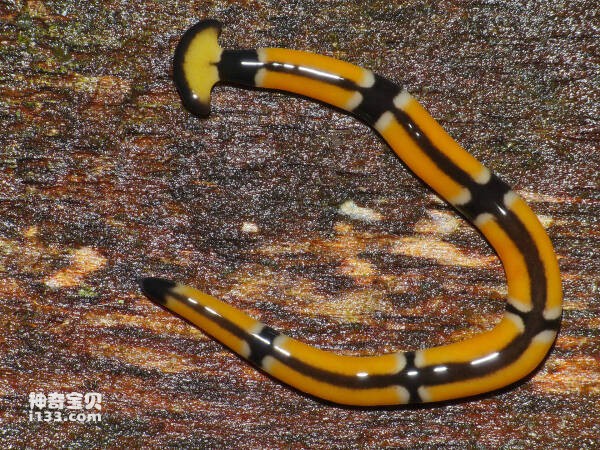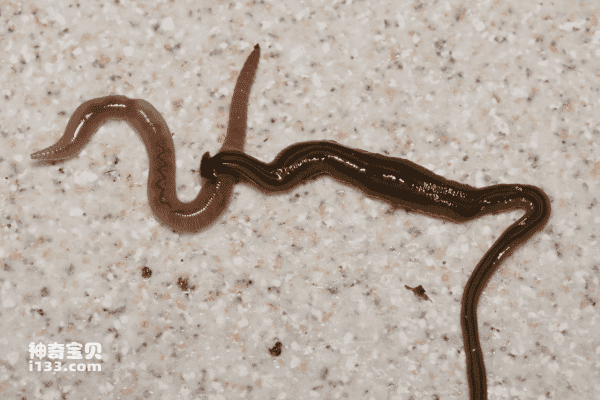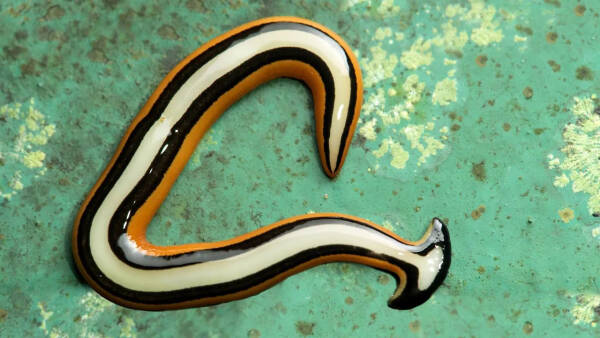The hammerhead (Bipalium sp.) is a fearsome, venomous terrestrial flatworm. This large planarian lives on land and is both a predator and a man-eater. While these unique-looking worms do not pose a direct threat to humans, they are an invasive species with the ability to wipe out earthworms.

Scientific name: Bipalium sp.
Other names: Broad-headed planarian, "landchovy"
Distinguishing Features: Large terrestrial planarian with a spade-shaped head and gastropods or "crawling soles"
Size range: from 5 cm (B. adventitia) to over 20 cm in length (B. kewense)
Diet: Carnivorous, feeds on earthworms and other animals
Lifespan: Possibly immortal
Habitat: Distributed around the world, prefers moist, warm habitats
Conservation status: Not assessed
Kingdom: Animalia
Phylum: Platyhelminthes
Class: crossbar class
Order: Trilobata
Section: Geophysics
Fun fact: Hammerheads are one of the very few terrestrial invertebrates known to produce the neurotoxin tetrodotoxin.
The hammerhead's most distinctive features are its fan-shaped or spade-shaped head and long, flat body. Planarians have a large "crawling sole" on their underside for locomotion. Species are distinguished by head shape, size, color and stripe pattern.
Terrestrial planarians are earthy in color, ranging from grey, brown, gold and green. Small hammerheads include Bacillus externa and range in length from 5 to 8 cm (2.0 to 3.1 in). In comparison, adult B. kewense worms can exceed 20 centimeters in length.

Hammerheads are native to tropical and subtropical regions but have become an invasive species worldwide. It is believed that planarians are accidentally transported and distributed on rooted garden plants. Since hammerheads require humidity, they are not commonly found in desert and mountain biomes.
Dilobite worms are carnivores that feed on earthworms, slugs, insect larvae, and each other. Worms use chemoreceptors located on the head or under the ventral groove to detect prey. Hammerhead worms stalk their prey, pushing it to the surface and entangling it in a sticky secretion. Once the prey is mostly immobile, the worm extends its pharynx from its body and secretes digestive enzymes, then uses cilia to draw liquefied tissue into its branching gut. When digestion is complete, the worm's mouth also acts as its anus.
Hammerheads store food in vacuoles in the digestive epithelium. The worms can survive for weeks on their reserves and eat away at their own tissues as food.

While some types of worms are edible, hammerhead sharks are not one of them. Planarians contain the potent neurotoxin tetrodotoxin, which the worms use to immobilize prey and deter predators. The toxin has also been found in pufferfish, blue-ringed octopuses and rough-skinned salamanders, but is not known to be present in any terrestrial species. Prior invertebrates were discovered in hammerheads.
Hammerheads are incorrectly called hammerhead slugs because they move in a slug-like manner. They use cilia on their crawling soles to glide along slime strips. The worms have also been observed descending along a trail of slime.
Terrestrial planarians are photonegative (light sensitive) and require high humidity. Therefore, they usually move and feed at night. They prefer cool, moist places, often living under rocks, logs, or bushes.
These worms are hermaphrodites, with each individual possessing testicles and ovaries. Hammerhead worms can exchange gametes with other worms through their secretions. The fertilized egg develops in the body and is excreted in the form of an oocyst. After about three weeks, the eggs hatch and the worms mature. In some species, the larvae are different in color from the adults.
However, asexual reproduction is more common than sexual reproduction. Hammerheads, like other planarians, are essentially immortal. Typically, worms reproduce through debris, leaving a tail tip that sticks to leaves or other substrate, and then develops into adults. If the worm is cut into pieces, each part can regenerate into a fully developed organism within a few weeks. Injured worms rapidly regenerate damaged tissue.

None of the hammerhead worm species are listed on the IUCN Red List, but there is no evidence that their populations are threatened. Terrestrial planarians are widely distributed in their natural tropical and subtropical habitats and have expanded their territorial range throughout the world. Once established in the greenhouse, the animals disperse to the surrounding areas. In cold climates, worms are able to survive freezing temperatures by seeking protected sites.
Researchers were concerned that terrestrial planarians might damage plants. Over time, they were considered harmless to greenery, but then a more insidious threat emerged. Hammerheads have the potential to wipe out earthworm populations. Earthworms are vital because they aerate and fertilize the soil. Hammerheads are considered a threatening invasive species. Some of the methods used to control slugs also work for flatworms, but their long-term effects on ecosystems have not been fully determined.
Ducey, PK; Cerqua, J.; West, LJ; Warner, M. (2006). Eberle, Mark E., editor. "Rare oocyst production in the invasive terrestrial planarian Bipalium Kewense". Southwest Naturalist. 51 (2): 252. doi: 10.1894/0038-4909(2006)51[252:RECPIT]2.0.CO;2
Ducey, PK; West, LJ; Shaw, G.; Dreier, J. (2005). "Reproductive ecology and evolution of the invasive terrestrial planarian Bipalium ventitium in North America." Pediatric Biology. 49(4):367.doi:10.1016/j.pedobi.2005.04.002
Ducey, P. K.; Messerre, M.; Lapointe, K.; North, S. (1999). "Luminrid prey and potential reptilian predators of the invasive terrestrial flatworm Bipalium ventitium (Turbellaria: Tricladida: Terriricola)". American Midland Naturalist. 141 (2): 305.doi: 10.1674/0003-0031(1999)141[0305:LPAPHP]2.0.CO;2
Ogren, R. E. (1995). "Predatory behavior of terrestrial planarians". Aquatic Biology. 305:105-111. Number: 10.1007/BF00036370
Stokes, AN; Ducey, PK; Neumann-Lee, L.; Hanifin, CT; France, SS; Pflander, ME; Brody, ED; Brody, Jr. ED (2014). "First identification and distribution of tetrodotoxin in terrestrial invertebrates: two terrestrial flatworm species (Bipalium ventitium and Bipalium kewense)". PLoS One. 9(6):e100718. doi:10.1371/journal.pone.0100718
Justin, Jean-Loup; Windsor Leigh; Guy, Delphine; Gross, Pierre; Jessica Trevino (2018). "Giant Worm". my heart! Hammerhead flatworms (Plathelminthes, Geoplanidae, Bipalium spp., Diversibipalium spp.) in mainland France and French overseas territories
animal tags: Hammerhead
We created this article in conjunction with AI technology, then made sure it was fact-checked and edited by a Animals Top editor.